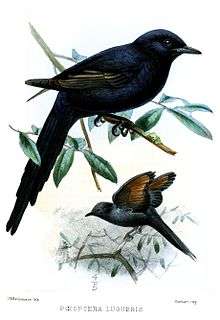Narrow-tailed starling
The narrow-tailed starling (Poeoptera lugubris) is a species of starling in the family Sturnidae. It is found in West and Central Africa from Sierra Leone to the Democratic Republic of the Congo.[1]
| Narrow-tailed starling | |
|---|---|
 | |
| Scientific classification | |
| Kingdom: | Animalia |
| Phylum: | Chordata |
| Class: | Aves |
| Order: | Passeriformes |
| Family: | Sturnidae |
| Genus: | Poeoptera |
| Species: | P. lugubris |
| Binomial name | |
| Poeoptera lugubris Bonaparte, 1854 | |
Description
The male is dark blue and the female is dark gray with chestnut-colored patches on the wings, visible in flight. Both sexes have long, narrow tails. Not a very noisy bird, this starling's vocalizations include shrill chirps, cries, and whistles.
Habitat
Its habitat is the canopy of lowland forest, making use of secondary forest and forest clearings.
Diet
It eats mostly fruit, and sometimes insects or seeds.
Behaviour
These starlings form flocks of 10-30 or more birds, and sometimes will mix with other fruit-eating birds. This bird is a colony-nester, making its nest high up in dead trees in holes originally excavated by colonial cavity-nesting barbets, sometimes with both birds nesting in close proximity. Eggs are pale blue-gray with brown spots.[2]
References
- BirdLife International (2012). "Poeoptera lugubris". IUCN Red List of Threatened Species. 2012. Retrieved 26 November 2013.CS1 maint: ref=harv (link)
- Feare, Chris; Craig, Adrian (1998). Starlings and Mynas. Christopher Helm. pp. 106, 245–246. ISBN 0-7136-3961-X.
